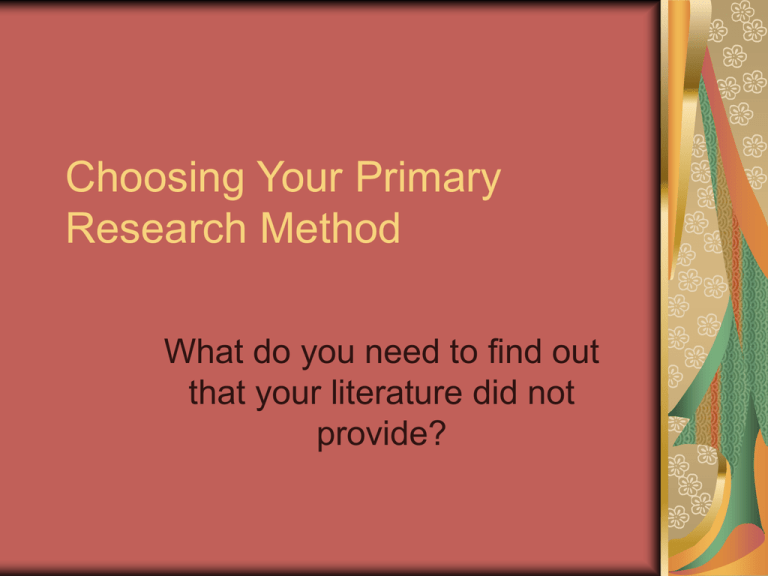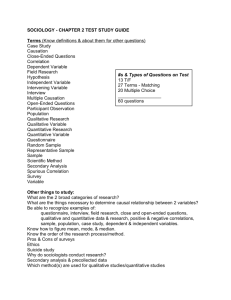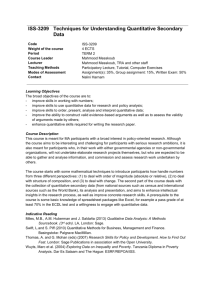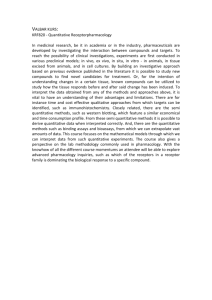Choosing Your Primary Research Method
advertisement

Choosing Your Primary Research Method What do you need to find out that your literature did not provide? Purpose of the Primary Research During library research, you investigated your problem in a broader sense to identify key strategies for solving the problem suggested by the literature. You learned how other organizations have dealt with this problem. Now, during primary research, you will investigate the local situation to develop workable solutions appropriate for them. Quantitative vs. Qualitative In the primary research phase of your project, your team will continue gathering information to find ways to answer your research question. Instead of using written sources, however, you will now collect data by means of a quantitative primary research tool, such as a survey by questionnaire a formal observation content analysis of company or organizational documents What is Quantitative Research? Quantitative research involves number crunching -- collection, tabulation, and interpretation of numbers. It allows you to say things like, “A majority of our survey respondents (83%) indicated they would be willing to take a paid 6-week training course during their lunch hour.” Findings like these easily lead to strong recommendations for your report! Requirements One primary research method, a quantitative one, is required. You may also choose to do an additional method, either qualitative or quantitative. No matter how many methods you use, one must be some type of quantitative research. Survey by Questionnaire If you need information about a group of people so you can describe something about that group statistically, administer a questionnaire to a sample group that represents them. Questionnaires are a good choice when you need to know “how many.” Students typically distribute their questionnaires to a sample group of about 25 people and collect them at the time of distribution. Controlled Observation If you want to observe behavior or activity as it occurs naturally and without interference from you as the researchers, use the observation method: Gather the data; then quantify and analyze it statistically. Decide what event or activities you can observe. It cannot be a casual observation where you say, “Over the past six years at American States Insurance I have observed a decline in service.” You must complete a minimum of 4 hours of controlled observation, looking for specific behaviors or actions. Prepare an observation form to record the data observed. (Ask me for examples. ) Content Analysis Examine business records, files, transcripts of conferences and/or minutes of meetings. Obtain accounts of an event or an issue as reported over a period of time in a newspaper or company report, (e.g., annual reports) to determine changes, patterns, etc. Develop a form to aid in quantifying and assessing the information you collect. Qualitative Research Tools Optional methods to gain further information Interview members of the target organization Letters of inquiry Focus groups Interview an expert (NOT the same as the target audience interview.) Selecting a Primary Research Tool What kind of information do you need? About what solutions or strategies mentioned in your articles would you like to question your respondents? Typically the primary research questions will help you assess respondents’ attitudes or interest in strategies you learned about from your literature. Who can provide this information? Members of your organization/employees? The general public? A specific demographic? Experts? Leadership at similar local organizations? Other? Will the information be valid, accurate and reliable? Data are valid when “they measure the factor or factors you intend them to measure" (Golen, Pearce, & Figgins, 1985, p. 44). Validity suggests that a logical conclusion can actually be drawn. "Reliable data are those that are measured consistently and accurately" (p. 45). This means that under the same circumstances, you will obtain the same results again and again. Determine answers to the following: What do you still need to know in order to make recommendations that are appropriate for your organization? What strategies mentioned in the literature could be applied to your local organization? As you read your articles and write your literature review, look for these! What primary research method would best help you gather the information you need? Will your target audience approve?











